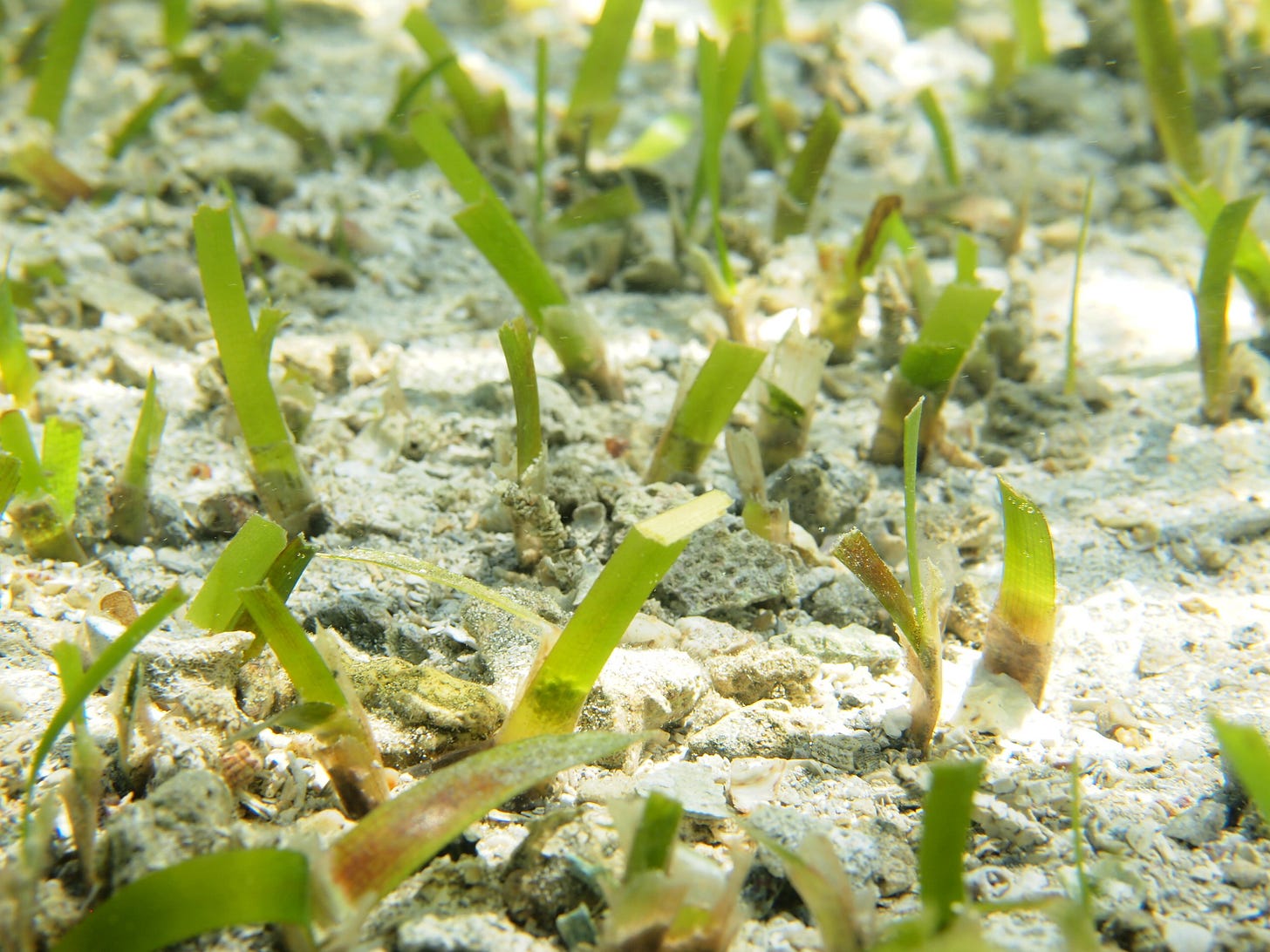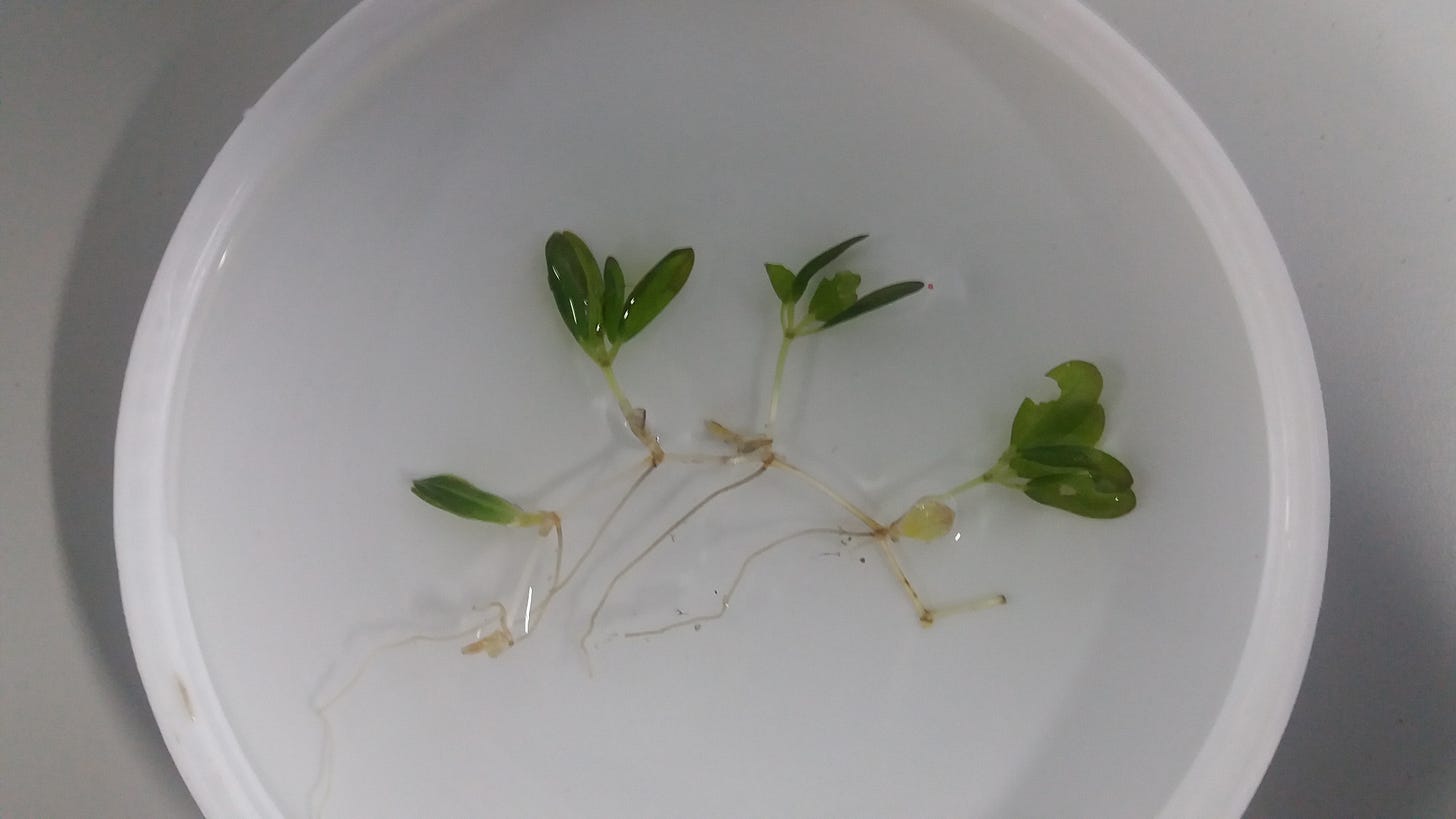Hello, and welcome to this latest edition of From a Climate Correspondent, a newsletter exploring the climate crisis around the globe.
Each week we share insights on the fight against climate change from our adoptive countries – this week from Costa Rica, where strong protective measures to protect the country from Covid-19 are impaction both research and tourism.
If you'd like to support us, you can invite us for a coffee over at our Patreon page. We're grateful for any contributions!
Thanks for reading and stay safe,
From a Climate Correspondent team - India, Jocelyn, Lou and Mat
How Covid-19 is impacting blue carbon
No.19 by Jocelyn Timperley

Thalassia testudinum seagrass from the Caribbean coast of Costa Rica in 2019. Image credit: Jimena Samper Villarreal
In a typical year, Costa Rica’s high season for tourism would start to wind down in the coming weeks. For obvious reasons though, tourism has been non-existent for several months now.
The country’s strong and early coronavirus measures, including closing the border to non-nationals, appear to be working. New recorded cases have never risen above about 30 per day, and have fallen to the single digits in recent days. Just five people are thought to have died due to coronavirus.
But as elsewhere, the economic impacts are hard to begin to grapple with. Tourism usually contributes 8% of Costa Rica’s GDP, with 3 million visitors in a country of 5 million residents. Now restaurants are shutting down and hotels are closing. At the beginning of this month, my landlord announced the hotel he owns in San José - the oh-so hispanically named Hotel Don Carlos - will permanently close. It had been in operation for 70 years. Some 42% of restaurants have closed, with 100,000 restaurant workers losing their jobs, according to Costa Rica’s service industry association.
There is also the informal economy to consider: a million people, close to half of Costa Rica’s workforce, are either employed without social security or self-employed without paying taxes.
The huge informal workforce that surround Costa Rica’s car culture, for example, will be seeing a huge hit in income from the ban on tourist entry into the country, closing of beaches and national parks, and restrictions on when cars can be on the road. For sellers of fresh coconut water and plantain crisps who appear wherever traffic jams do and the ‘watchi-manes’ who watch over parked cars for a couple of coins, fewer cars on the road means a drop in an already precarious income.
Costa Rica’s coastal zones rely particularly heavily on tourism, which in turn provide a strong incentive for protecting local ecosystems - including the mangroves and seagrasses which form the country’s stocks of “blue carbon”. The coming weeks and months will put this eco-tourism model, and the ecosystems it supports, severely to the test as local communities see their income plummet.
Science hold-up
As in many countries, field research by scientists is also being affected by the restrictions put in place due to coronavirus. Jimena Samper Villarreal from the University of Costa Rica is a specialist in seagrasses - flowering plants which grow in marine environments. She says there are already gaps in data for some of her regular monitoring projects.
“We have a lot of restrictions on what we're able to do as far as lab work and field work,” she tells me. “We weren't able to do our monitoring for this March for our monitoring programme on the southern Caribbean. There will be a gap because the beaches and the national parks are closed and we're not able to access the sites.”
Costa Rica is still in the early stages of characterising its seagrasses, one of several marine habitats known to store “blue carbon”, along with mangroves and salt marshes. Coastal ecosystems are among the most carbon-rich places on Earth, but also some of the most threatened, with hundreds of thousands of hectares destroyed each year.

Halophila baillonii seagrass from the Pacific coast of Costa Rica. Image credit: Jimena Samper Villarreal
”There's a lot of carbon being stored not just in the biomass of these habitats - so the vegetation the plants themselves take CO2 from the atmosphere and store it through photosynthesis in their tissues - but then they also store a lot of that carbon in the soil and the sediments,” says Samper Villarreal.
Costa Rica only published its first seagrass map in 2018, and much of the research here is still concerned with pinpointing where, how much and what species of seagrasses are in which parts of the country’s coast. At the same time, Samper Villarreal and her colleagues are also collecting samples to quantify the amount of carbon contained within these systems - and whether it is changing.
“We do know that we have lost sea grasses on the Pacific coast in several places, mostly due to storm events and that sort of thing,” she says. On the Carribean side, the CARICOMP monitoring programme now missing samples due to coronavirus measures has found losses of seagrass biomass, potentially due to anthropogenic impacts.
Blue carbon politics
I first saw Samper Villarreal speak at the pre-COP in Costa Rica, where a “blue room” was dedicated to talks and presentations on all things blue. Among the presentations here was a talk on behalf of the Australian government on supporting the inclusion of blue carbon in countries' new climate pledges.
Australia is thought to hold around 12% of the world's “blue carbon” habitats and has pledged millions to protect them. A major paper on Australia’s blue carbon last year was the first to comprehensively assess the carbon of a country’s salt marshes, sea grasses and mangroves, says Samper Villarreal.
This growing focus on the climate and other benefits of blue carbon is certainly a positive development. But knowing a little of the Australian government’s poor track record on climate change, I felt a little sceptical. The IPCC’s report on oceans warned against countries replacing emission reduction policies with climate benefits from blue carbon ecosystems, and Australia has been accused of using its action on blue carbon as a “smokescreen for inaction” on its pollution elsewhere.
More research is definitely needed to better understand these important ecosystems - including in places like Costa Rica, which lack the funds for the expensive chemical analysis needed. Establishing baselines, just happening now in Costa Rica, is certainly essential to ensuring we understand the changes occuring in these ecosystems, and implement the right management and policies to protect them. But we also need to ensure action on blue carbon sequestration goes hand in hand with policies to cut emissions elsewhere too.
For now, researchers like Samper Villarreal are doing what they can to continue the crucial science on blue carbon, despite the closed beaches.
Must reads from the region
Mainstreaming blue carbon to finance coastal resilience, Shimul Bijoor, GreenBiz
Oceans and coastal plant ecosystems are some of the most efficient known carbon sinks, but among the most threatened by climate change, writes Bijoor. Their critical contribution as sources of "blue carbon" has only recently begun to gain traction in market-based ecosystem management discussions.
Fight against Amazon destruction at stake after enforcement chief fired, Sam Cowie, Mongabay
Bolsonaro has sacked the enforcement director of Brazil’s environmental agency after he took strong action against illegal miners in the Amazon.
Plans to boost economies with oil crash along with prices, Manuela Andreoni, Alejandra Cuéllar, Fermín Koop, Andrés Bermúdez Liévano, Diálogo Chino
The investment crash in oil due to the price slump, as well as a drop in oil revenue, will affect a host of oil-producing nations in Latin America, including Mexico, Argentina, Venezuela, Brazil, Colombia and Ecuador, a group of Diálogo Chino’s editors explain. But what does this mean for renewables?
The Climate Debt: What the West Owes the Rest, Mohamed Adow, Foreign Affairs
Not from Latin America, but extremely relevant there too. Adow’s excellent in-depth piece sets out the history of climate justice and why wealthy countries should be making far deeper emissions cuts and supporting poorer countries to develop without the need to emit - including financially.
What else I've been reading
The Future We Choose: Surviving the Climate Crisis, Christiana Figueres & Tom Rivett-Carnac
Costa Rica’s most famous climate change figure recently released her new book, “The Future We Choose”. Written with Rivett-Carnac, the book outlines the case for action-led hope on climate change. Figueres, Rivett-Carnac and their friend Paul Dickinson also host the podcast Outrage + Optimism podcast, now in its second season, which is notable for its incredible access to interviewees. Jane Goodall, Greta Thunberg, Richard Branson and John Kerry have all made an appearance.
Been forwarded this email?
Did someone send this on to you? Why not sign up yourself!
Who we are
Lou Del Bello is an energy and climate journalist based in Delhi, India.
Jocelyn Timperley is a freelance climate & science journalist based in San José, Costa Rica.
India Bourke is an environment journalist based in Hong Kong.
Mat Hope is investigative journalist based in Nairobi, Kenya.


